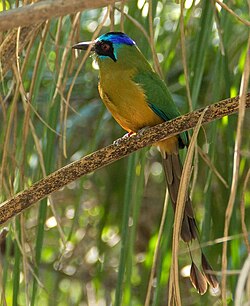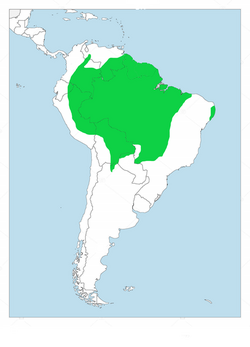Biology:Amazonian motmot
| Amazonian motmot | |
|---|---|

| |
| Scientific classification | |
| Domain: | Eukaryota |
| Kingdom: | Animalia |
| Phylum: | Chordata |
| Class: | Aves |
| Order: | Coraciiformes |
| Family: | Momotidae |
| Genus: | Momotus |
| Species: | M. momota
|
| Binomial name | |
| Momotus momota | |

| |
range
| |
| Synonyms | |
|
Ramphastos momota Linnaeus, 1766 | |
The Amazonian motmot (Momotus momota) is a colorful near-passerine bird in the family Momotidae. It is found in the Amazon lowlands and low Andean foothills from eastern Venezuela to eastern Brazil and northeastern Argentina.[2]
Taxonomy and systematics
The Amazonian motmot and the blue-capped (Momotus coeruleiceps), whooping (M. subrufrescens), Trinidad (M. bahamensis), Lesson's (M. lessonii), and Andean motmots (M. aequatorialis) were all at one time considered conspecific.[3][4][5] The Amazonian motmot has nine recognized subspecies; they are listed in the "Distribution and habitat" section below.[2]
Description
thumb|left|Close-up view of the head The Amazonian motmot's plumage varies among the subspecies. The bodies of all are shades of green. All have a long tail that has extended feathers with racquet tips that are green or black. Most have a black eyemask, though their size and shape differ. The central crown is black and surrounded or partially bordered by a blue band. The nominate subspecies has a chestnut nape. Momotus momota ignobilis and M. m. cametensis have more extensive chestnut on the neck and face.[4]
Distribution and habitat
The Amazonian motmot is widely distributed in South America east of the Andes. Nine subspecies are recognized:[2]
- Momotus momota momota — eastern Venezuela, Guyana, Suriname, French Guiana, and northern Brazil
- M. m. microstephanus — southeastern Colombia, eastern Ecuador, and northwestern Brazil
- M. m. ignobilis — eastern Peru and western Brazil
- M. m. nattereri — northeastern Bolivia
- M. m. simplex — western to west central Brazil south of the Amazon
- M. m. cametensis — north central Brazil
- M. m. parensis — northeastern Brazil
- M. m. marcgravianus — eastern Brazil
- M. m. pilcomajensis — southern Bolivia, southern Brazil, and northwestern Argentina
Throughout its range the Amazonian motmot inhabits the interior and edges of humid lowland forest. It is found up to 1,200 m (3,900 ft) in Venezuela, to 1,000 m (3,300 ft) in Ecuador, and to 750 m (2,460 ft) in Peru.[4]
Behavior
Feeding
The Amazonian motmot is omnivorous. It has been documented eating insects and other arthropods, small mammals and reptiles, and fruit.[4]
Breeding
Like most Coraciiformes, the Amazonian motmot nests in long tunnels in earth banks. Very little else is known about its breeding phenology.[4]
Vocalization
The Amazonian motmot's song has been described as "a fast, hollow hoo-do" and "a bubbling whOOP-oo"[1]. It also makes "a gruff kak", sometimes in a series.[2][4]
References
- ↑ BirdLife International (2016). "Momotus momota". IUCN Red List of Threatened Species 2016: e.T61634607A95173087. doi:10.2305/IUCN.UK.2016-3.RLTS.T61634607A95173087.en. https://www.iucnredlist.org/species/61634607/95173087. Retrieved 7 October 2023.
- ↑ 2.0 2.1 2.2 Gill, F.; Donsker, D.; Rasmussen, P. (January 2021). "IOC World Bird List (v 11.1)". https://www.worldbirdnames.org/.
- ↑ Remsen, J. V., Jr., J. I. Areta, E. Bonaccorso, S. Claramunt, A. Jaramillo, D. F. Lane, J. F. Pacheco, M. B. Robbins, F. G. Stiles, and K. J. Zimmer. Version 19 January 2021. A classification of the bird species of South America. American Ornithological Society. https://www.museum.lsu.edu/~Remsen/SACCBaseline.htm retrieved January 19, 2021
- ↑ 4.0 4.1 4.2 4.3 4.4 4.5 Orzechowski, S. C. and T. S. Schulenberg (2020). Amazonian Motmot (Momotus momota), version 1.0. In Birds of the World (T. S. Schulenberg, Editor). Cornell Lab of Ornithology, Ithaca, NY, USA. https://doi.org/10.2173/bow.bucmot4.01 retrieved May 5, 2021
- ↑ Stiles, F. Gary (2009). "A review of the genus Momotus (Coraciiformes:Momotidae) in Northern South America and adjacent areas" (PDF). Ornitología Colombiana 8: 29–75. ISSN 1794-0915. http://www.coraciiformestag.com/Research/Motmot/momotustaxonomy.pdf. Retrieved May 5, 2021.
Wikidata ☰ Q904932 entry
 |


